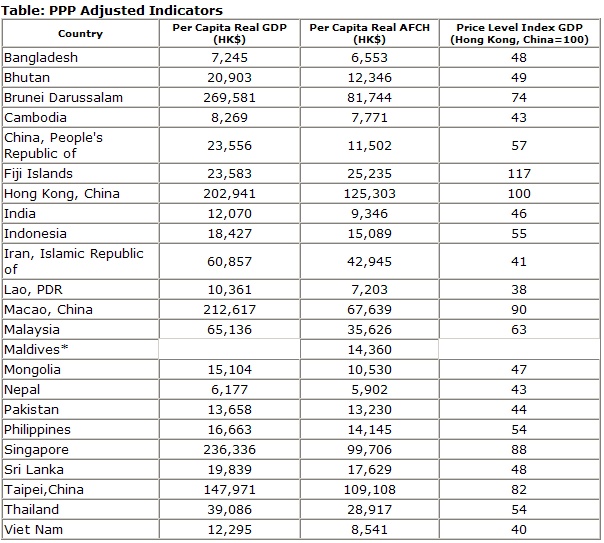However, a completely different picture emerges if the size of these economies is adjusted by population. Rather than dominating the rankings, the PRC and India drop to tenth and eighteenth positions, respectively, out of the 22 economies participating in the full GDP comparison, as shown in the table below.
Similarly, the PRC ranks 15th and India ranks 17th when economies are compared based on “actual final consumption of households” (AFCH), a better measure of economic well-being of the population.
The AFCH is a measure of what households actually consume, comprising of what they purchase and what they are supplied for individual use by the government (principally education and health). The economic well-being of the population is obtained by comparing household consumption expenditure per capita.
The five economies that top the list are Hong Kong, China (HK$125,303 per capita); Taipei,China (HK$109,108); Singapore (HK$99,706), Brunei Darussalam (HK$81,744), and Macao, China (HK$67,639).
The five economies that are at the bottom of the survey are Nepal, Bangladesh, Lao PDR, Cambodia, and Viet Nam.
As for the people living in the two giant economies, a person living in the PRC spends an average of only HK$11,502 per year, while an Indian consumes an average of HK$9,346 per year.
Purchasing Power Parities (PPP) is an idea popularized by The Economist’s Big Mac Index which prices hamburgers in global cities for a quick and crude comparison of living standards. The ICP is more comprehensive as it covers a broader range of commodities.
Based on the Price Level Index, which is the ratio of the PPP to the exchange rate, Fiji Islands and Hong Kong, China are the two costliest places to live in. They are followed by Macao, China; Singapore; and Taipei,China.
PRC ranks eighth, and India ranked 16th in terms of PLIs. Price levels in the Philippines, Thailand, and Indonesia are very similar and are close to the Asian average.
The cheapest places are Lao PDR, Viet Nam, Islamic Republic of Iran, Cambodia, and Nepal.
“The results provide the most comparable information on breakdown of GDP expenditures across the Asia Pacific,” ADB Chief Economist Ifzal Ali says. “Purchasing Power Parities are a more appropriate currency converter to compare living standards and the structure of economies than market exchange rates.”
The results are deployed for investment strategies, the global campaign against poverty and national policies such as appropriate spending on schools or infrastructure in Asia.
Using real GDP, estimates were done using assumed growth rates and how long it will take some countries to reach certain levels of per capita real GDP. For example, it will take the Philippines more than 20 years to reach Thailand’s present per capita real GDP level if it grows at an average annual per capita rate of 3.7%. Looking at PRC, it needs only 16 years to reach the $HK100,000 per capita real GDP level but nearly 30 years to catch up with Brunei, based on an annual per capita growth rate of 9.2%. India needs more than 30 years to come up to the $HK100,000 per capita real GDP level, and almost 50 years to match Brunei’s per capita real GDP, if India continues to grow at an annual per capita rate of 6.5%.
The ICP Asia Pacific is part of a global initiative managed by the Asian Development Bank in collaboration with the ICP Global Office and other regional agencies across the world. The ICP results, for the first time, enable a robust cross-country comparison of major macroeconomic indicators across diverse economies of Asia and the Pacific.






